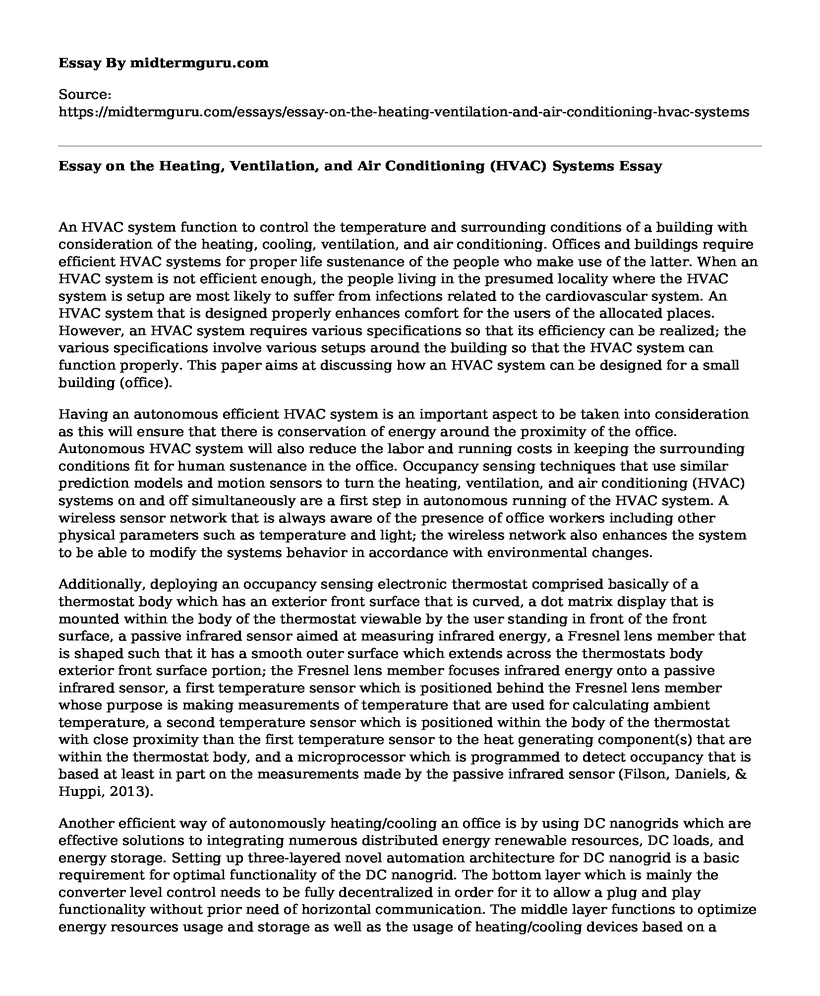An HVAC system function to control the temperature and surrounding conditions of a building with consideration of the heating, cooling, ventilation, and air conditioning. Offices and buildings require efficient HVAC systems for proper life sustenance of the people who make use of the latter. When an HVAC system is not efficient enough, the people living in the presumed locality where the HVAC system is setup are most likely to suffer from infections related to the cardiovascular system. An HVAC system that is designed properly enhances comfort for the users of the allocated places. However, an HVAC system requires various specifications so that its efficiency can be realized; the various specifications involve various setups around the building so that the HVAC system can function properly. This paper aims at discussing how an HVAC system can be designed for a small building (office).
Having an autonomous efficient HVAC system is an important aspect to be taken into consideration as this will ensure that there is conservation of energy around the proximity of the office. Autonomous HVAC system will also reduce the labor and running costs in keeping the surrounding conditions fit for human sustenance in the office. Occupancy sensing techniques that use similar prediction models and motion sensors to turn the heating, ventilation, and air conditioning (HVAC) systems on and off simultaneously are a first step in autonomous running of the HVAC system. A wireless sensor network that is always aware of the presence of office workers including other physical parameters such as temperature and light; the wireless network also enhances the system to be able to modify the systems behavior in accordance with environmental changes.
Additionally, deploying an occupancy sensing electronic thermostat comprised basically of a thermostat body which has an exterior front surface that is curved, a dot matrix display that is mounted within the body of the thermostat viewable by the user standing in front of the front surface, a passive infrared sensor aimed at measuring infrared energy, a Fresnel lens member that is shaped such that it has a smooth outer surface which extends across the thermostats body exterior front surface portion; the Fresnel lens member focuses infrared energy onto a passive infrared sensor, a first temperature sensor which is positioned behind the Fresnel lens member whose purpose is making measurements of temperature that are used for calculating ambient temperature, a second temperature sensor which is positioned within the body of the thermostat with close proximity than the first temperature sensor to the heat generating component(s) that are within the thermostat body, and a microprocessor which is programmed to detect occupancy that is based at least in part on the measurements made by the passive infrared sensor (Filson, Daniels, & Huppi, 2013).
Another efficient way of autonomously heating/cooling an office is by using DC nanogrids which are effective solutions to integrating numerous distributed energy renewable resources, DC loads, and energy storage. Setting up three-layered novel automation architecture for DC nanogrid is a basic requirement for optimal functionality of the DC nanogrid. The bottom layer which is mainly the converter level control needs to be fully decentralized in order for it to allow a plug and play functionality without prior need of horizontal communication. The middle layer functions to optimize energy resources usage and storage as well as the usage of heating/cooling devices based on a Multi-Agent System. Finally, the top layer of the DC nanogrid functions as the user interface and the port of communication to the Energy Network Operator; the purpose of this is to enable smart grid capabilities for example, demand side management, grid support, and demand response. This novel automation architecture requires combination of dynamic direct heating systems with heat pumps that are highly efficient (Riccobono, et al, 2016).
References
Filson, J. B., Daniels, E. B., & Huppi, B. (2013). U.S. Patent No. 8,558,179. Washington, DC: U.S. Patent and Trademark Office.
Riccobono, A., Ferdowsi, M., Hu, J., Wolisz, H., Jahangiri, P., Muller, D., ... & Monti, A. (2016, April). Next generation automation architecture for DC smart homes. In Energy Conference (ENERGYCON), 2016 IEEE International (pp. 1-6). IEEE.
Cite this page
Essay on the Heating, Ventilation, and Air Conditioning (HVAC) Systems. (2021, Jun 11). Retrieved from https://midtermguru.com/essays/essay-on-the-heating-ventilation-and-air-conditioning-hvac-systems
If you are the original author of this essay and no longer wish to have it published on the midtermguru.com website, please click below to request its removal:
- Why Was Baghdad Constructed as a Round City Rather Than a Square City?
- Essay on Exxon Valdez Oil Spill
- Essay on BPs Oil Spill
- Paper Example on Importance of Oil and Gas Industry for Texas Economy
- Master Degree in Architectural Engineering - Admission Essay
- Manifold in Gas and Oil Industry - Research Paper
- Network Analysis Approach for Optimal Project Execution in Engineering Industry - Research Paper







